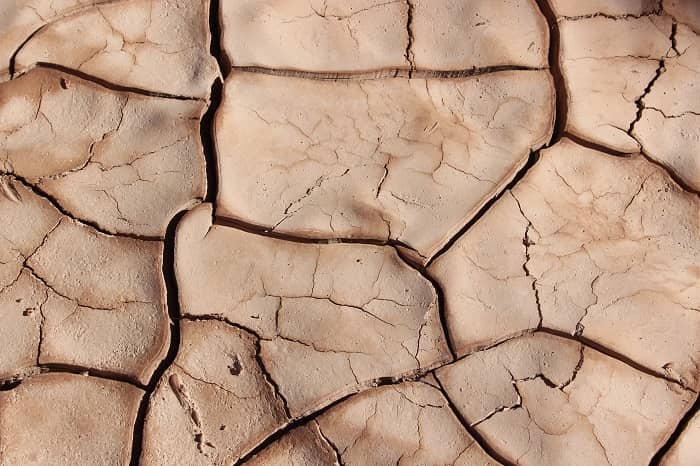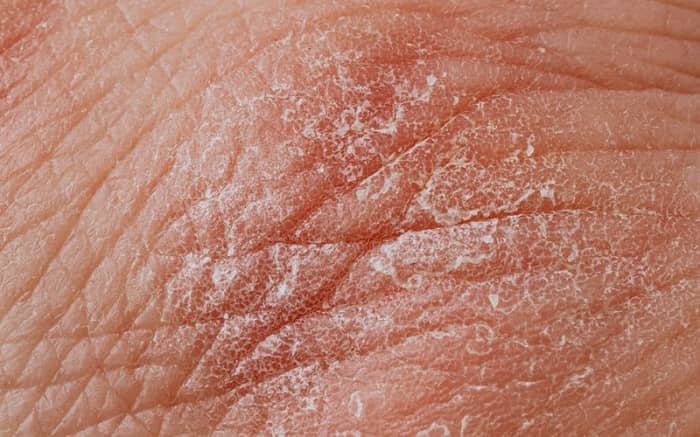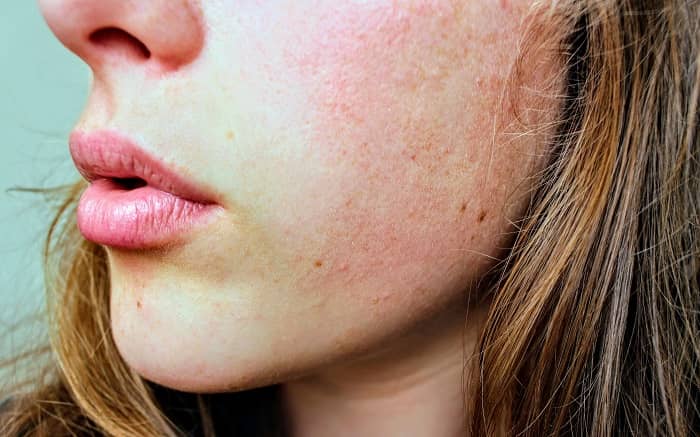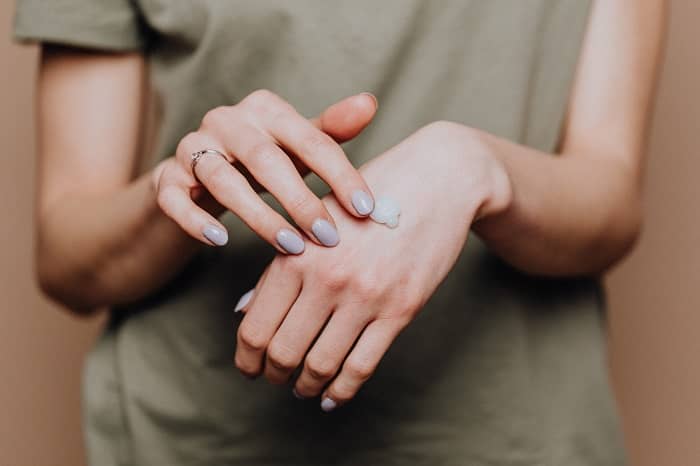
07 Jul Causes and Remedies for Dry Skin Patches [The Only Guide You Need]
White dry patches can be much more serious than just a feeling of skin tightness!
Causes of dry skin patches can be weather changes, aging, or even something as simple as dehydration. Or, on the flip side, it can even hint at something more serious, such as psoriasis or rosacea.
And did you know even mental health issues can cause dry skin?
Well, Flaky dry skin patches are common as the fall approaches.
But when they start making appearances before the fall, your skin might be under some serious threat.
It could be an early sign of dry skin.
Fortunately, there are cures for dry skin. Some can be even done at home without professional assistance. More on this later.
First off, there’s a thick difference between normal dry skin and this sort of patchy dry skin.
The usual dry skin would just feel tight when you storm out from the shower and would ultimately fade away to the touch of a hydrating moisturizer.
But these raised, scaly-looking, and white dry patches on the skin just don’t let your skin breath and are often impervious to moisture. Moreover, finding a treatment could be really hectic unless you know exactly what causes dry spots on face.
When you know the reasons behind sudden dry skin, you know the right way to get rid of them.
Hence, the following segments highlight what causes dry patches on the skin along with their symptoms and treatment of dry patches on skin.
What Causes Dry Patches on Skin [Most Common Reasons]

There are many external factors that can cause your skin to break or become dry.
Here’s what causes dry patches on face:
- Age
- The climate where you are living
- Genetics
- Occupation
- Dehydration
- Poor nutrition
- Taking too many hot showers
- Mental health
Here’s why these factors are worth your attention and what you can do about them:
#1. Age
Age is a common reason behind dry skin patches on face caused due to water loss from the stratum corneum. The symptoms are often beyond your control.
How to Treat Dry Skin Due to Aging?
- One thing you can start doing from today onwards is applying a moisturizer that suits your skin.
- When choosing a moisturizer, go for the ones made for dry skin and have no fragrance as they may cause issues for sensitive skin people. An oil-based moisturizer can help repair the compromised skin barrier function.
- Stop using harsh soaps and surfactants on the skin.
- Using a humidifier to add moisture to your room is also effective.
#2. Climate

This is an environmental condition inflicting your skin with dry and scaly patches much like those you see during winters. Cold temperatures often cause low humidity causing dry skin flare-ups.
How to Treat Dry Skin from Weather Change?
- Lower the bath durations in winters
- Use a humidifier if dry skin is caused by cold weather
- Always use warm water instead of hot water to take baths
- Apply a moisturizer with humectants that also have some occlusive emollients in there to seal in the moisture. Some water-based moisturizers may also contain oil to lock in the humectants.
- After applying moisturizer, wear clothing that covers your body during winters.
#3. Genetics
Research has proven that dry skin could also be due to genetics. Mutation in genes can affect the formation and hydration of the skin barrier.
What to Do About Dry Skin from Genetics?
- Don’t skip daily moisturization
- Look for a moisturizer that has peptides and ceramides. Something that has been specifically made to improve the skin barrier function will work really well.
#4. Occupation
Sometimes what causes dry spots on your face and white scaly patches is your job.
People working in a hairdressing salon, hospital, farming, and construction are especially susceptible to such conditions as they have to expose their skin to water on a constant basis.
Another subset of workers with dry skin complaints is often exposed to chemicals and latex while working for manufacturing or machine operations.
In such conditions, dry, scaly, and rough skin are common along with burning, swelling, and blisters.
How to Prevent and Fix Dry Skin at Work?
- Do not clean your hands with mineral spirits, turpentine, or other chemicals.
- Keep a moisturizer in your bag to apply after washing your hands.
- Apply and then reapply a broad-spectrum sunscreen throughout the day if you’ve got a field job.
- Wear clean clothing and remember to take off chemically stained clothes before leaving the workplace.
- Keep safety wear with you.
- Always keep abreast of workplace safety protocols. For instance, keep informed about what to do in case your skin gets exposed to chemicals.
#5. Dehydration
This condition is technically easier to handle. Moreover, this is also one of the most common reasons for dry skin.
Whether it’s summers or winters, you need to drink enough water to keep your skin plump. Technically, you lose water each day in summers when you’re sweating.
Thus, it becomes crucial to rehydrate your skin with fresh water supply each day.
How to Cure Dry Skin of Dehydration?
- Drink enough water, even if it winters.
- Apply a water-based moisturizer for added hydration.
- Avoid drinking caffeinated drinks and teas. Go decaf.
#6. Poor Nutrition

Dry Skin from Poor Diet is quite common for those who are not paying attention to their daily meal plan.
Having a diet that’s high in sodium, fried foods, and sugars can encourage inflammation and may cause bad conditions for your skin to repair itself.
How to Fix Dry Skin from a Poor Diet?
- Eat more omega-3 fatty acids. If you like eating fish, eat more salmon and sardines. Or, if you’re a vegan, go for walnuts, almonds, and flaxseeds.
- Eat more colorful foods, such as green and red veggies. Broccoli, beetroots, cabbage, and spinach are good examples.
- Munch on dry fruits and fruits in general when you’re snacking.
- Avoid packaged chips, fries, and soft drinks.
#7. Too Many Hot Showers
It’s not uncommon to bathe in hot water during winters. However, too hot water can strip your skin off its protective oils and leave behind dry, scaly patches.
How to Fix Dry Skin from Hot Showers?
- Use lukewarm water instead of hot water to bathe.
- Use a soft towel to pat dry.
- Apply a rich moisturizer or olive oil right after stepping out of the shower.
#8. Mental Health
Whether it’s stress or anxiety, mental health can take its toll on your skin. It can even affect your immune system, which will eventually show up on your face.
Long-term stress tends to compromise the skin’s barrier function leading to all sorts of skin health issues. It can even exacerbate existing skin conditions.
Moreover, mental illness and personal hygiene are also interconnected.
Mental illness may cause you to miss out on taking proper care of your skin, which may cause even more issues down the line.
How to Heal Dry Skin from Mental Health Issues?
- Start exercising to lower your anxiety and stress levels.
- Try meditation and other relaxing breathing techniques to calm down your nerves.
- Try upside-down exercises for a healthy rush of blood to your head and to improve overall blood circulation.
- Take one step at a time and develop a simple skincare routine you can follow.
Finally, if nothing else works, talk to a therapist to navigate your emotions better and have better control over your thoughts.
As your mental health improves, it will eventually start having a positive effect on your skin as well.
So, now that you know what causes white scaly patches on skin, what are you going to do about it?
Even if your dry patches on skin are not itchy, you need to take measures for better care of your skin to protect its youthful longevity.
Moving on…
Along with the above causes, you must check if the following medical conditions are causing dry skin.
If yes, the scope of treatment and care may vary based on your symptoms.
What Causes Small Dry Patches on Skin? [Specific Skin Conditions]

On a molecular level, dry patches are caused by defects under the skin in particular areas, such as weak moisture barrier, low-density oil glands, or even deficiency of proteins.
But what causes these molecular changes is what we should look for.
Some of the most common causes of dry, rough skin on the neck and other parts include:
#1. Psoriasis
It is an inflammatory condition of the skin which results in making the skin dry. Usually, such patches appear to be red or silver and are thickly firm.
Although it can affect any part of your skin, the most common areas under attack include your face.
According to surveys, almost 50% of people suffering from psoriasis have dry patches on the face.
Some common symptoms of the condition include:
- Itchy dry patches on the skin
- Burning sensation around the area
- Skin appears to peel off or flake
- Small bumps appear around the patches
- Dry and cracked skin
How to Get Rid of Dry Skin Due to Psoriasis?
The treatment involves the prevention of the skin cells to grow rapidly and form scales.
Home Remedies
- Use aloe vera – Aloe vera is effective in reducing the itchiness and the redness in the areas where the skin has gone dry.
- Eat a healthy diet – Your diet must not include red meat, saturated fats, sugars, carbs, and alcohol. Rather try enriching your diet with cold-water fish, seeds, nuts, and sources of omega-3-fatty acids.
- Bath with Epsom salt – Use Epsom salt in lukewarm water to calm down the itchiness and those scaly appearances.
- Turmeric – Use turmeric in your food as it has the ability to reduce inflammation around the patches.
- Sunlight exposure – Some daily exposure to the sun has been effective in treating the condition. However, wear a broad-spectrum SPF at all times.
Topical Creams
- Corticosteroids – They are usually prescribed by docs for treating mild cases of psoriasis. You can avail of it in the form of creams, gels, and ointments. However, long-term usage can affect your skin’s texture.
- Retinoids – Available in the form of gels that you can use on your skin twice a day. However, they might show some side effects for sensitive skin types.
#2. Eczema

Eczema is a common group of skin disorders characterized by red inflamed skin. It could be inherited in childhood, but people might develop it in adulthood as well.
According to surveys, almost 15 million people in the US have been affected by Eczema showing signs like itchy skin.
Though it could occur anywhere, the main target areas are around the cheeks and eyes.
Symptoms of Eczema
- Rashes and bumpy skin
- Dry patches
- A peeling appearance of skin
- Itchy skin
- Skin flushing
- Scaly patches
How to Get Rid of Dry Skin from Eczema?
There are various ways through which you can improve the symptoms.
Natural Remedies
- Apple Cider Vinegar – It balances the skin’s pH and fights bacteria helping to reduce skin infections. You can either use it in a wet wrap or go for a vinegar bath soak.
- Oatmeal – Colloidal oatmeal lotion can help treat the condition at home as it has antioxidant and anti-inflammatory effects. You can use powdered colloidal oatmeal in your bath too. Just shred the rolled oats in a grinder and it’s ready.
- Coconut Oil – It is a rich source of fats that helps reduce the dryness around the patches.
Medications
The doctor might prescribe you:
- Corticosteroids
- Antibiotics
- Antiviral or antifungal medicines
- Barrier repair moisturizers
#3. Contact Dermatitis
It’s a subtype in the group of diseases that come under eczema. It is actually an allergic reaction that occurs because of contact with the allergic substance.
Its symptoms usually match with the other types of eczema. But it is not inheritable even in kids.
Symptoms of Contact Dermatitis:
- Red rashes
- Severe itchiness around the area
- Bumps and blisters on the skin can even show crusts
- Swelling and burning sensation around the patches
- Ulcers
How to Treat Dry Skin from Dermatitis?
You could either try out the home remedies or the medications and ointments. But we would suggest you wait out on going for medical treatments unless the condition is severe.
Home Remedies
- Cool Compress – Use a cold damp cloth to dab on the areas affected. This would reduce inflammation and irritation.
- Lukewarm baths – Oatmeal or baking soda can be added to lukewarm water for reducing itching and irritations.
- Moisturizers and lotions – Use a fragrance-free moisturizer to moisturize your skin and keep it hydrated.
Medications
Only when your dermatitis is too severe, your doc would recommend corticosteroids, either in the form of pills, gels, or ointments.
That totally depends on the severity.
#4. Rosacea

Rosacea, as the name suggests, flushes your cheeks red. Usually, it affects women over 30, but it can affect others too.
The common area under attack here remains the face showing signs like pimples, irritation, and bumps.
Though there hasn’t been much evidence on what causes rosacea, docs suggest it comes from nervous system issues.
Symptoms of Rosacea:
- Flushed cheeks
- Redness around different areas
- Pus filled bumps with a burning sensation
- Blood vessels are often visible
- Skin feels tight
How to Get Rid of Dry Skin from Rosacea?
There’s not much to panic about the condition as you can treat it to some of the common natural remedies.
Home Remedies
- Turmeric – A daily supplement of turmeric can help fight the inflammation and other signs of rosacea. You can take supplements or even mix them in water and drink.
- Ginger – Add 1 or 2 inches of ginger in water and let it boil. Now, simmer it for a few seconds and then strain it. Drink this 2 to 3 times daily.
- Aloe vera gel – Its healing properties can be unlocked by applying it to the area and letting it stay for 30 – 40 minutes before washing it off.
- Raw honey – Apply it to the affected area and wash it off after 30 minutes.
But in case the symptoms are severe, you might need some medications.
Medications
- Antibiotics – To stop the spread of any bacteria that might attack your blisters and bumps
- Vitamin A – It prevents blockages of hair follicles to reduce the tendency of bumps popping up.
- Topical antiseptic – It prevents the growth of microorganisms on the skin.
#5. Seborrheic Dermatitis
It usually affects the scalp but can also appear on other areas where the oil glands are active like the side of the nose and near eyebrows.
The major cause behind this medical condition is an abnormal reaction of your immunity to a yeast called Malassezia yeast.
This yeast is a normal resident on your skin.
Symptoms of Seborrheic Dermatitis:
- Dandruff around your scalp, eyebrows, mustache, or beard
- Patches of greasy skin accompanied with yellow scales or white flakes.
- Redness around skin
- Itching sensation
Treatment for Dry Skin from Seborrheic Dermatitis
There are various natural ways with which you can reduce the symptoms and even heal the condition.
Natural Remedies
- Fish oil – Supplements rich in fish oil can reduce the burning sensations and even cut off the tendency to catch allergic reactions.
- Aloe vera – You can use aloe vera supplements here to curb the symptoms.
- Probiotics – Probiotics are effective in treating different types of seborrheic dermatitis as they help in healthy digestion.
- Olive oil – Applying olive oil to your scalp can help reduce the symptoms. All that you gotta do is oil your scalp and leave it for an hour. Then rinse with a mild shampoo.
- Diet – Include leafy veggies, tomatoes, fruits with antioxidants, and almonds in your diet to fight off inflammation.
But if these remedies don’t work and your condition remains severe, it’s time to ring in the doctor who will prescribe you some chemical treatments.
Chemical Treatments
Though it is self-treatable, the doc usually suggests using a shampoo that contains either of the following:
- Coal Tar
- Ketoconazole
- Salicylic acid
- Selenium sulfide
#6. Actinic Keratosis
Usually, the Actinic Keratosis shows its first signs in the form of spots that seem like sandpaper in texture.
Eventually, these spots grow up to become scaly with crusts.
Though they are usually benign, rare cases might turn out to be skin cancer.
Hence, it is something to be concerned about.
Symptoms of Actinic Keratosis
- Itching or burning sensation
- Rough patches of skin which can just be felt and not seen
- Dry lips
- Red scaly bumps might appear
- White dry skin patches
How to Treat Dry Skin Patches from Actinic Keratosis?
Though you can treat it naturally, since it’s a form of a benign tumor, we suggest you refer to a doctor too.
Natural Remedies
- Apple cider vinegar – Take a small piece of cotton and dip it in the vinegar. Dab this cotton over the affected area. Though it might have a pinching sensation, it would work.
- Tea tree oil – Dip your fingers in the oil and apply it to the affected area.
- Green tea – Soak the green tea bag in warm water and then use the bag on the affected areas. Leave the bag until the water dries up. Repeat this 2 – 3 times a day for best results.
However, if you feel your condition is severe, we suggest you visit a doctor.
Chemical Treatments
These are the medications doctors usually prescribe:
- Anti-tumor medications
- Chemotherapy and non-steroidal anti-inflammatory drugs
- Photodynamic therapies
#7. Atopic Dermatitis
It is one of the most common types of eczema which usually causes red patches around the arms, legs, and cheeks.
Though several factors can contribute to this condition, stress is one of the most popular causes.
Symptoms of Atopic Dermatitis
- Dry and scaly skin
- Redness and itching
- Cracks around the ears
- Crusted and weepy sores
How to Treat Dry Skin from Atopic Dermatitis?
If the condition is in the initial stage, you can make some lifestyle changes and try out natural remedies.
Natural Remedies
- Moisturize your skin twice daily.
- Use anti-itch cream on the affected area.
- Take warm baths with Epsom salt.
- Keep a humidifier at home to reduce the dryness around the skin.
- Take measures to address stress and anxiety.
But these tips generally don’t work for severe cases, and, there, you might need to consult a doc.
Medical Treatments
- Oral drugs that control inflammation like corticosteroids for scaly skin treatment
- Injectables called dupilumab
- Creams that control itching like tacrolimus
- Drugs that control infections like the antibiotics
So, you now know that your skin cannot be ignored as even it can be affected by medical conditions.
Hence, the best way to stay away from such medical conditions is prevention.
How to Prevent Dry Patches on Skin?

For preventing the external environment or your health from making your skin go from fab to dab, make sure you follow some tips listed below:
- Always cleanse your face with a mild cleaner that doesn’t contain any harmful fragrances or chemicals.
- Showers should not be extended more than 10 minutes.
- Instead of going for hot showers, go for warm water.
- Don’t go out in the sun without an SPF, and never expose your skin to the sun too much as the UV rays can be harmful.
- Use a good-quality moisturizer after bathing or cleansing your skin to lock the hydration.
- Never rub your skin vigorously, rather dry it by patting. Also, minimize the number of times you scrub your face in a week.
- Stay hydrated and drink plenty of water to keep your skin moist as dehydration can take away all the moisture that skin holds.
- Take special care of your diet. What you eat is what your skin shows. Go for healthy diets that contain healthy fats like monounsaturated fats and polyunsaturated fats.
- Smoking and alcohol are two things that can never lead your skin to become healthy and good. Hence, avoid such bad habits.
Closing Thoughts
People often fail to understand if their skin is showing signs of medical condition or is just affected by the regular external environment.
In such cases, the color of the skin is the best indicator of the factors that cause dry patches.
For instance:
The red patch often shows eczema when it’s around the knees, face, and elbow. But it shows keratosis pilaris when it’s around the arms and thighs.
White ones around the elbows and knees are just basic dryness, but when red skin with white scales appears, it shows psoriasis.
On the other hand, the brown color usually shows actinic keratosis caused by sun rays.
So, you see how confusing it can be to judge what is behind those dry scaly patches.
However, taking all of the above-mentioned factors into account can help you determine what causes dry skin patches on face and what could be the best treatment.
In the end, prevention with a regular skincare routine is better than expensive medical treatments.



No Comments